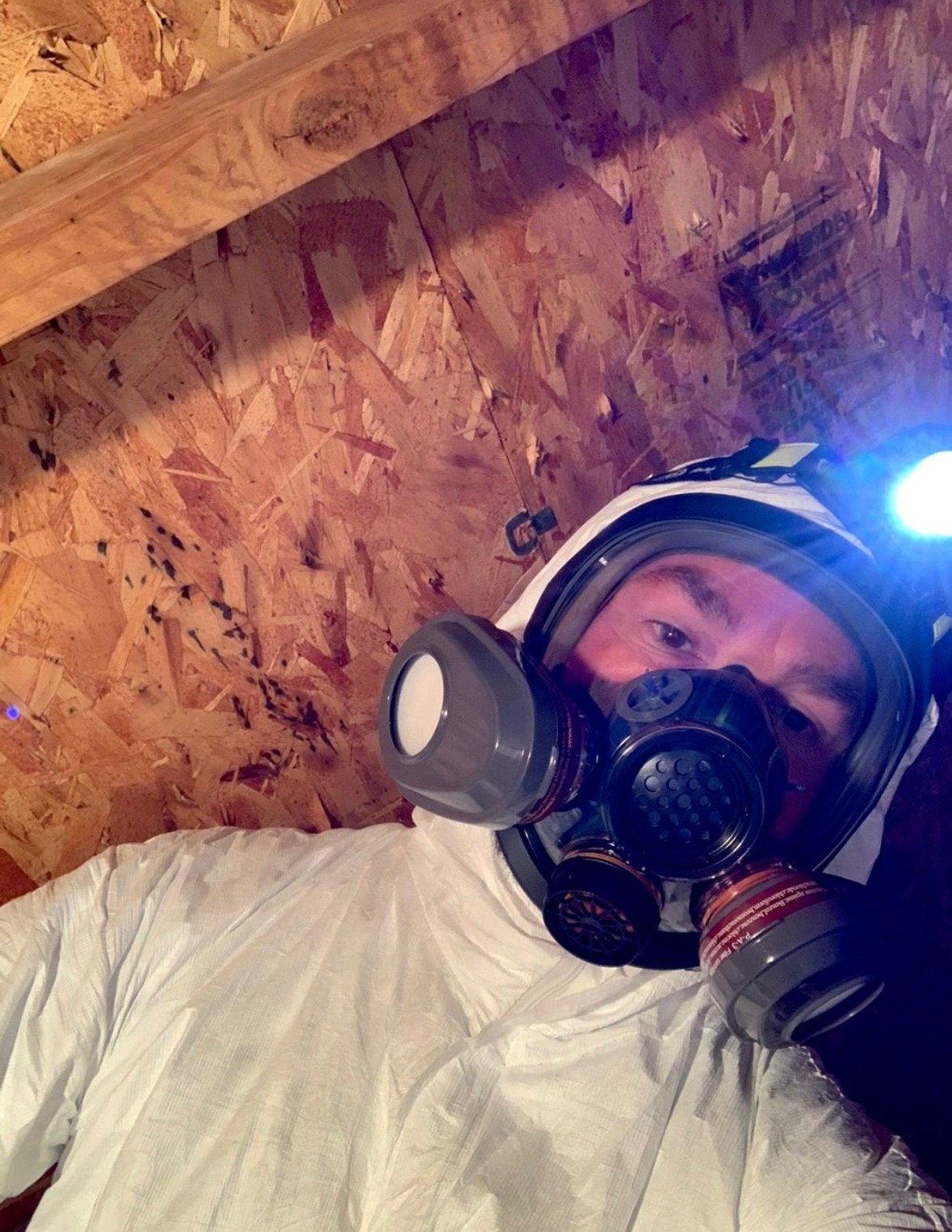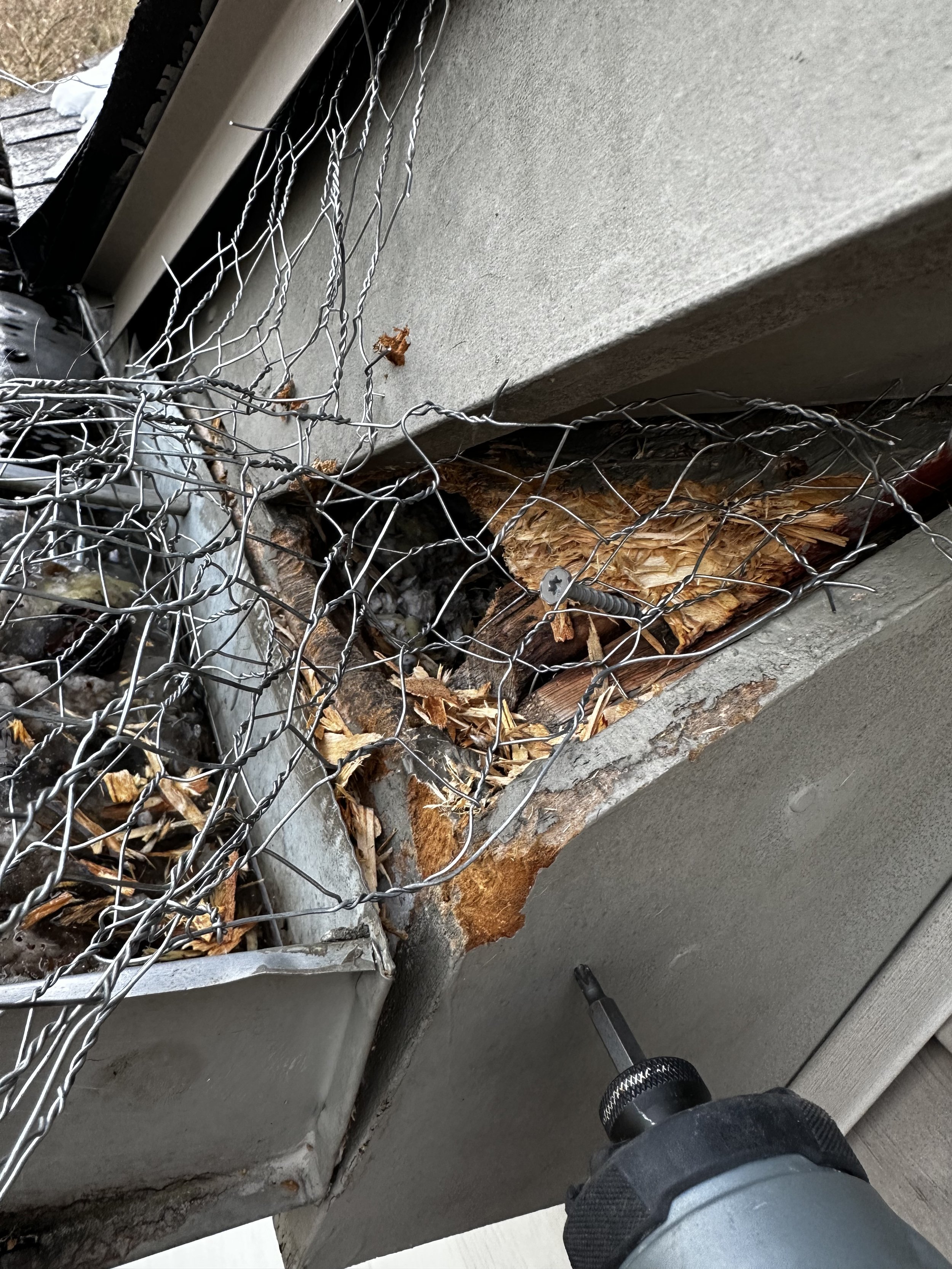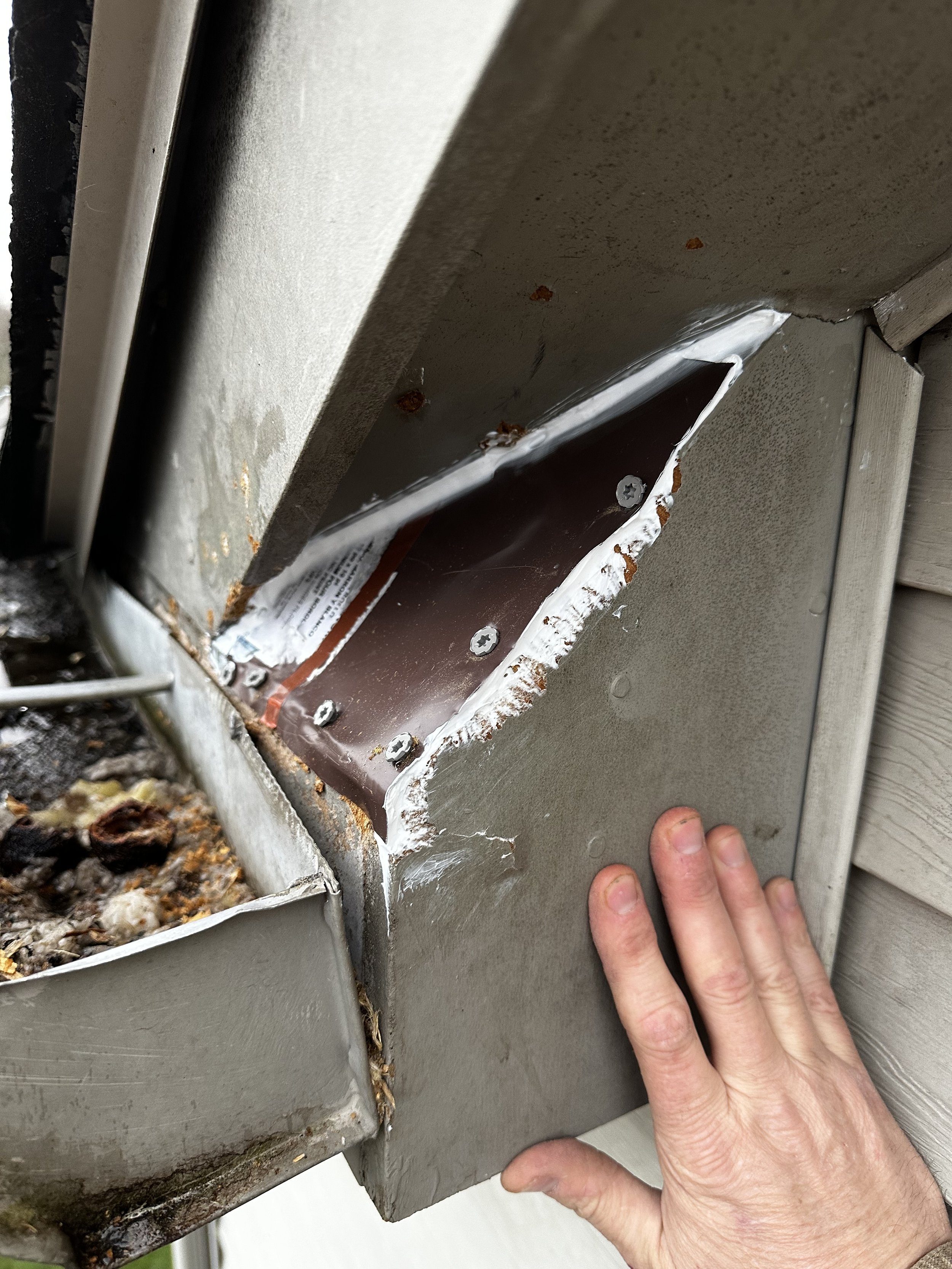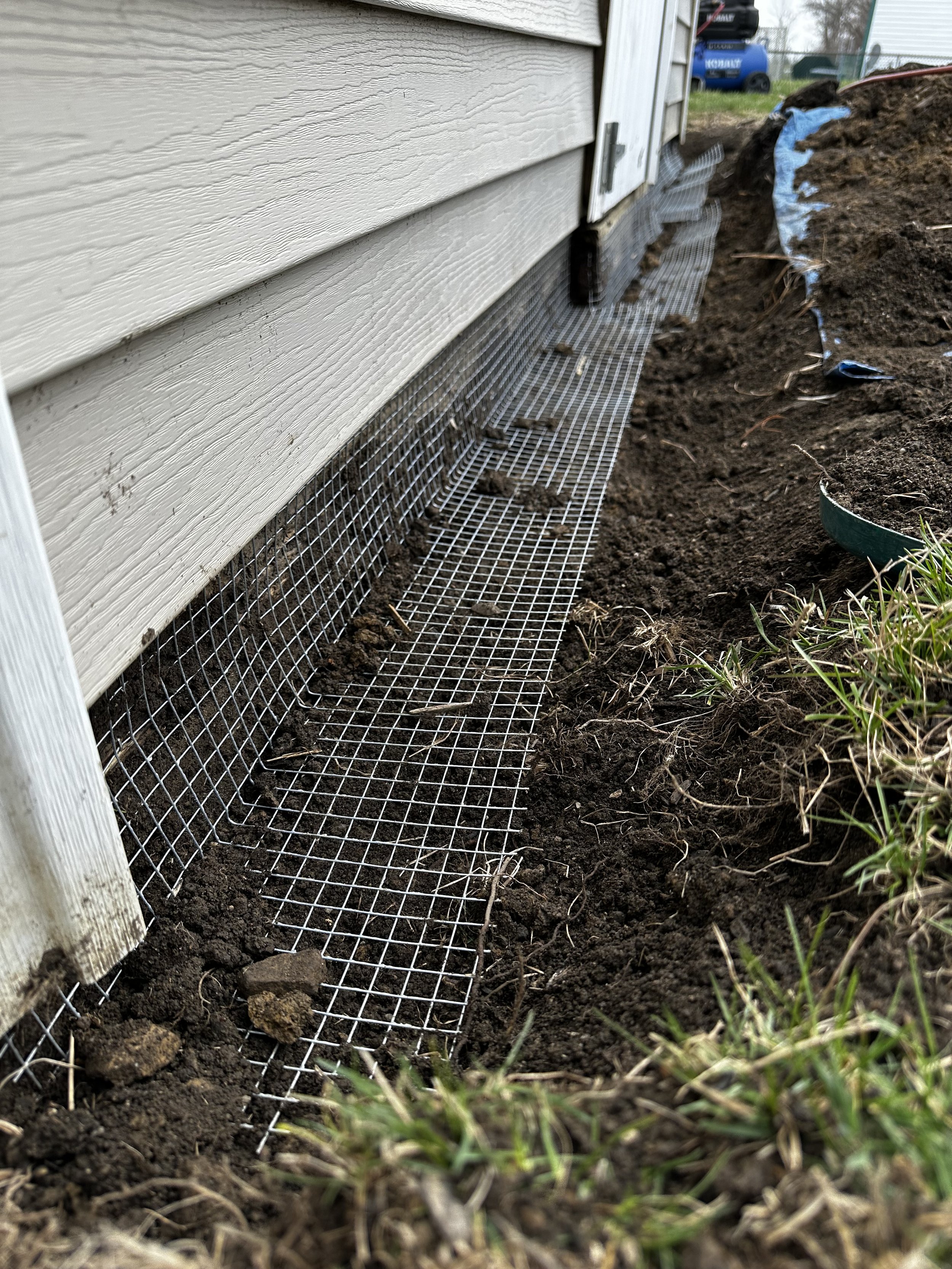
Important Info and
Parts of The Removal Process

Let's talk about BATS! If you suspect a colony of Bats in your attic, gable vent or garage please remember that Bats are a protected species in the State of Ohio and cannot be lawfully killed. They should be removed as soon as possible because their feces can contain a disease known as histoplasmosis. This disease affects the human lung and respiratory system. You should not remove or disturb Bat feces without the proper respirator to protect your lungs from the harmful dust and feces.

This is a typical entry point for Raccoons. They will push up against the roof with their backs against the soffit, which is typically just aluminum and then they are in your attic. Once the soffit begins to move, the Raccoons continue to push until they have an easy access point. Subsequent remediation after removal is the only way to stop this. In this photograph, I was able to reinforce and reuse the existing soffit. You can see just how dirty it is from the raccoons accessing the attic from this point. Plywood is placed behind the soffit to prevent the Raccoons from pushing it up and getting into your attic. 614Wildlife takes pride in invisible exclusion work. Typically the exclusion work cannot be seen by the human eye.

This is Tyler baiting a trap on the roof. You can see the techniques being used to prevent the trap from not sliding off the roof while also not drilling holes into the shingles (which some larger companies will do, and that then can lead to water damage in your home.) Remember 614Wildlife is a small and local owned business, we want to always make sure we are not leaving more damage than we came to fix.

Another view of a typical access point used by Raccoons to push into your attic through the soffit. This is a typical positive set used to force the animal through the traps using the access point that the animal had created. This assures we are catching and removing the specific animal(s) that is in the attic. In the photo Tyler has used two double door traps in the event there were two raccoons.

Sometimes we have to get creative to keep te Raccoons and squirrels from sneaking by the traps. Blocking off all access points forces the animal into the trap for removal. Video cameras are used in conjunction with trapping to confirm catch times or bait theft when using bait. This helps make trapping and the removal process the most efficient for you. Some of the configurations are truly works of art and the ONLY way to prevent animals bypassing the traps.

We use cameras in conjunction with our traps. This helps us prevent the animals being left in the traps longer than necessary, while also showing us when the animal was trapped or if the bait had been taken. These trail cameras are used with a live feed directly to Tyler's phone to document any catches or non-target animals. This helps us quickly release the non-target animal and get the trap working for the nuisance wildlife again. In this case we were dealing with cats in the attic and soffit using the same hole as the Raccoons. This helped us get the cats out of the traps as soon as possible.

Luke (Tyler's son) pulling traps from a Raccoon job. We had to get through five feral cats that were living in the attic before we were able to get to the Raccoon who had been cohabitating with the cats. Pulling traps mean the animals have been safely removed and you can enjoy your space again!

This was a temporary fix by the home owner to attempt to keep squirrels out of the soffit and attic at the fascia board. Unfortunately Squirrels are able to chew through the wood and are not deterred by the chicken wire. Take a look in the next picture to see how 614Wildlife made sure that the Squirrels could not gain entry into this attic. This was not visible from the ground and an extreme exclusion at the fascia.

This area was not visible from the ground and was problematic as the squirrels kept trying to chew the wood. Squirrels must be removed or they will return. 614Wildlife was able to use aluminum to permanently stop the squirrels from continuing to enter and cause damage. 614Wildlife has the knowledge and experience to not only remove the animals from your space, but also fix and remediate their entry point. This was an extreme measure that was not visible.

Tyler setting a positive set Squirrel trap. Positive sets are double door traps that force the animal through the trap using the only access point that was created by the animal when it broke into your home. This assures the problem animal will be removed from your attics or crawlspace. This Squirrel had chewed a hold in the gable vent of the house. The entire gable vent had to be covered with hardware cloth with the positive set trap at the hole in the gable vent. Once removed the gable vent was covered with hardware cloth. This is typically done from the inside of the attic so the exclusion work is not visible. This is one of the specialties of 614Wildlife. Exclusion work that is not visible and in this instance it prevented Squirrels and Bats from gaining access through the gable vent into the attic.

This is an example of a positive set trap under a deck. The entire open area of the deck must be blocked off forcing the animal through the trap. this was a Groundhog set under the deck.

This is an example of extreme measures taken using a positive set trap to force a Squirrel into the trap using the hole it had created. The need to block off all other options is very important. Squirrels gain access through the soffit or fascia and get into the attic. There they can have their babies in the warm comfort of your attic in the soft insulation. Squirrels must be removed from the location not just excluded from the home or they will come back and chew a new way into your home.

Completed exclusion job. Wire hardware cloth must be buried to prevent future intrusion and digging. Oftentimes groundhogs that were born in a certain space will come back to check if that space is open. Exclusion work is one of the specialties of 614Wildlife. Blocking off the access from future nuisance Wildlife is key to keeping your space free from, Groundhogs, Raccoon, Skunk, Opossum, and Voles.

Exclusion work in the process. This shows what is needed to keep the animals out in the future. Depending on the type of animals you are having trouble with 614Wildlife will make the recommendation on depth of wire and how far out the wire needs to be. Groundhog exclusion strategies are different than Vole exclusion work.

614Wildlife know that your yard and shed space should be returned to their original look and appearance. The exclusion work by 614Wildlife is typically hidden as you can see from the photos. Tyler and Luke take care to reduce the impact of their exclusion work and you can see here they have used tarps to preserve the ground while working.

A typical deck space positive set for Groundhogs and Raccoons. This deck had several holes that were dug by the animal and 614Wildlife set 5 positive set traps to block every hole with a trap thus ensuring the animals were removed as humanly and efficiently as possible.

Positive set for Groundhog along the foundation of the home. The Groundhog had dug along the foundation of the crawlspace and basement. In this instance the animals had gained access to the crawlspace under the house and got into the basement. As you can see in the photo the Groundhog was not the only nuisance Wildlife living in the basement and a long the crawlspace. We first caught a Raccoon and then a Groundhog.
